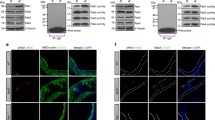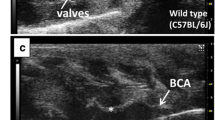Abstract
The ubiquitin–proteasome system is involved in the development and progression of atherosclerosis. The aim of this study was to investigate whether plaque composition is affected by proteasome function. In vitro, the potent and selective proteasome inhibitor bortezomib induced apoptosis in both cultured smooth muscle cells (SMCs) and activated macrophages. This effect was associated with increased expression of C/EBP homologous protein and cleavage of caspase-12, indicative of endoplasmic reticulum stress. The sensitivity to the proapoptotic effects of proteasome inhibition correlated with the protein synthesis rate. Proteasome inhibition in explanted atherosclerotic plaques of ApoE-deficient mice resulted in a significant decrease in SMCs and macrophages, indicating that both cell types in the atherosclerotic plaque were susceptible to the proapoptotic effects of proteasome inhibition. In vivo proteasome inhibition in ApoE-deficient mice did not affect plaque size or composition of early atherosclerotic plaques, but resulted in a significant decrease in collagen content as well as a significant enlargement of the necrotic core in advanced atherosclerotic plaques. In conclusion, our results indicate that an impaired proteasome function promotes features of a more rupture-prone plaque phenotype.






Similar content being viewed by others
References
Adams J, Palombella VJ, Sausville EA, Johnson J, Destree A, Lazarus DD, Maas J, Pien CS, Prakash S, Elliott PJ (1999) Proteasome inhibitors: a novel class of potent and effective antitumor agents. Cancer Res 59:2615–2622
Arpinati M, Chirumbolo G, Nicolini B, Agostinelli C, Rondelli D (2009) Selective apoptosis of monocytes and monocyte-derived DCs induced by bortezomib (Velcade). Bone Marrow Transpl 43:253–259
Chade AR, Herrmann J, Zhu X, Krier JD, Lerman A, Lerman LO (2005) Effects of proteasome inhibition on the kidney in experimental hypercholesterolemia. J Am Soc Nephrol 16:1005–1012
Chauhan D, Singh A, Brahmandam M, Podar K, Hideshima T, Richardson P, Munshi N, Palladino MA, Anderson KC (2008) Combination of proteasome inhibitors bortezomib and NPI-0052 trigger in vivo synergistic cytotoxicity in multiple myeloma. Blood 111:1654–1664
Clarke MC, Figg N, Maguire JJ, Davenport AP, Goddard M, Littlewood TD, Bennett MR (2006) Apoptosis of vascular smooth muscle cells induces features of plaque vulnerability in atherosclerosis. Nat Med 12:1075–1080
Croons V, Martinet W, Herman AG, De Meyer GRY (2008) Differential effect of the protein synthesis inhibitors puromycin and cycloheximide on vascular smooth muscle cell viability. J Pharmacol Exp Ther 325:824–832
Cusack JC Jr, Liu R, Houston M, Abendroth K, Elliott PJ, Adams J, Baldwin AS Jr (2001) Enhanced chemosensitivity to CPT-11 with proteasome inhibitor PS-341: implications for systemic nuclear factor-kappaB inhibition. Cancer Res 61:3535–3540
Cusack JC Jr, Liu R, Houston M, Abendroth K, Elliott PJ, Adams J, Baldwin AS Jr (2001) Enhanced Chemosensitivity to CPT-11 with proteasome inhibitor PS-341: implications for systemic nuclear factor-{{kappa}}B Inhibition. Cancer Res 61:3535–3540
De Meyer GRY, Van Put DJM, Kockx MM, Van Schil P, Bosmans R, Bult H, Buyssens N, Vanmaele R, Herman AG (1997) Possible mechanisms of collar-induced intimal thickening. Arterioscler Thromb Vasc Biol 17:1924–1930
Di Filippo C, Marfella R, D’Amico M (2008) Possible dual role of ubiquitin–proteasome system in the atherosclerotic plaque progression. J Am Coll Cardiol 52:1350–1351
Dwivedi A, Sala-Newby GB, George SJ (2008) Regulation of cell-matrix contacts and beta-catenin signaling in VSMC by integrin-linked kinase: implications for intimal thickening. Basic Res Cardiol 103:244–256
Gautier EL, Huby T, Witztum JL, Ouzilleau B, Miller ER, Saint-Charles F, Aucouturier P, Chapman MJ, Lesnik P (2009) Macrophage apoptosis exerts divergent effects on atherogenesis as a function of lesion stage. Circulation 119:1795–1804
Glickman MH, Ciechanover A (2002) The ubiquitin–proteasome proteolytic pathway: destruction for the sake of construction. Physiol Rev 82:373–428
Herrmann J, Edwards WD, Holmes DR Jr, Shogren KL, Lerman LO, Ciechanover A, Lerman A (2002) Increased ubiquitin immunoreactivity in unstable atherosclerotic plaques associated with acute coronary syndromes. J Am Coll Cardiol 40:1919–1927
Herrmann J, Saguner AM, Versari D, Peterson TE, Chade A, Olson M, Lerman LO, Lerman A (2007) Chronic proteasome inhibition contributes to coronary atherosclerosis. Circ Res 101:865–874
Herrmann J, Soares SM, Lerman LO, Lerman A (2008) Potential role of the ubiquitin–proteasome system in atherosclerosis: aspects of a protein quality disease. J Am Coll Cardiol 51:2003–2010
Hideshima T, Chauhan D, Richardson P, Mitsiades C, Mitsiades N, Hayashi T, Munshi N, Dang L, Castro A, Palombella V, Adams J, Anderson KC (2002) NF-kappa B as a therapeutic target in multiple myeloma. J Biol Chem 277:16639–16647
Kamat AM, Karashima T, Davis DW, Lashinger L, Bar-Eli M, Millikan R, Shen Y, Dinney CP, McConkey DJ (2004) The proteasome inhibitor bortezomib synergizes with gemcitabine to block the growth of human 253JB-V bladder tumors in vivo. Mol Cancer Ther 3:279–290
Kim SC, Rho MC, Lee HS, Kim YK, Kim K (2003) Caspase-3-dependent apoptosis in vascular smooth muscle cell by proteasome inhibition. J Cardiovasc Pharmacol 42:554–560
Laufer EM, Reutelingsperger CP, Narula J, Hofstra L (2008) Annexin A5: an imaging biomarker of cardiovascular risk. Basic Res Cardiol 103:95–104
LeBlanc R, Catley LP, Hideshima T, Lentzsch S, Mitsiades CS, Mitsiades N, Neuberg D, Goloubeva O, Pien CS, Adams J, Gupta D, Richardson PG, Munshi NC, Anderson KC (2002) Proteasome inhibitor PS-341 inhibits human myeloma cell growth in vivo and prolongs survival in a murine model. Cancer Res 62:4996–5000
Lowik CW, Alblas MJ, van de Ruit M, Papapoulos SE, van der Pluijm G (1993) Quantification of adherent and nonadherent cells cultured in 96-well plates using the supravital stain neutral red. Anal Biochem 213:426–433
Marfella R, D’Amico M, Di Filippo C, Baldi A, Siniscalchi M, Sasso FC, Portoghese M, Carbonara O, Crescenzi B, Sangiuolo P, Nicoletti GF, Rossiello R, Ferraraccio F, Cacciapuoti F, Verza M, Coppola L, Rossi F, Paolisso G (2006) Increased activity of the ubiquitin–proteasome system in patients with symptomatic carotid disease is associated with enhanced inflammation and may destabilize the atherosclerotic plaque: effects of rosiglitazone treatment. J Am Coll Cardiol 47:2444–2455
Marfella R, D’Amico M, Esposito K, Baldi A, Di Filippo C, Siniscalchi M, Sasso FC, Portoghese M, Cirillo F, Cacciapuoti F, Carbonara O, Crescenzi B, Baldi F, Ceriello A, Nicoletti GF, D’Andrea F, Verza M, Coppola L, Rossi F, Giugliano D (2006) The ubiquitin–proteasome system and inflammatory activity in diabetic atherosclerotic plaques: effects of rosiglitazone treatment. Diabetes 55:622–632
Martinet W, De Bie M, Schrijvers DM, De Meyer GRY, Herman AG, Kockx MM (2004) 7-Ketocholesterol induces protein ubiquitination, myelin figure formation, and light chain 3 processing in vascular smooth muscle cells. Arterioscler Thromb Vasc Biol 24:2296–2301
Meiners S, Laule M, Rother W, Guenther C, Prauka I, Muschick P, Baumann G, Kloetzel PM, Stangl K (2002) Ubiquitin–proteasome pathway as a new target for the prevention of restenosis. Circulation 105:483–489
Meiners S, Ludwig A, Lorenz M, Dreger H, Baumann G, Stangl V, Stangl K (2006) Nontoxic proteasome inhibition activates a protective antioxidant defense response in endothelial cells. Free Radic Biol Med 40:2232–2241
Meister S, Schubert U, Neubert K, Herrmann K, Burger R, Gramatzki M, Hahn S, Schreiber S, Wilhelm S, Herrmann M, Jack HM, Voll RE (2007) Extensive immunoglobulin production sensitizes myeloma cells for proteasome inhibition. Cancer Res 67:1783–1792
Myoishi M, Hao H, Minamino T, Watanabe K, Nishihira K, Hatakeyama K, Asada Y, Okada K-i, Ishibashi-Ueda H, Gabbiani G, Bochaton-Piallat M-L, Mochizuki N, Kitakaze M (2007) Increased endoplasmic reticulum stress in atherosclerotic plaques associated with acute coronary syndrome. Circulation 116:1226–1233
Nakagawa T, Zhu H, Morishima N, Li E, Xu J, Yankner BA, Yuan J (2000) Caspase-12 mediates endoplasmic-reticulum-specific apoptosis and cytotoxicity by amyloid-beta. Nature 403:98–103
Nathans D (1964) Puromycin inhibition of protein synthesis: incorporation of puromycin into peptide chains. Proc Natl Acad Sci USA 51:585–592
Nawrocki ST, Bruns CJ, Harbison MT, Bold RJ, Gotsch BS, Abbruzzese JL, Elliott P, Adams J, McConkey DJ (2002) Effects of the proteasome inhibitor PS-341 on apoptosis and angiogenesis in orthotopic human pancreatic tumor xenografts. Mol Cancer Ther 1:1243–1253
Neubert K, Meister S, Moser K, Weisel F, Maseda D, Amann K, Wiethe C, Winkler TH, Kalden JR, Manz RA, Voll RE (2008) The proteasome inhibitor bortezomib depletes plasma cells and protects mice with lupus-like disease from nephritis. Nat Med 14:748–755
Obeng EA, Carlson LM, Gutman DM, Harrington WJ Jr, Lee KP, Boise LH (2006) Proteasome inhibitors induce a terminal unfolded protein response in multiple myeloma cells. Blood 107:4907–4916
Palombella VJ, Rando OJ, Goldberg AL, Maniatis T (1994) The ubiquitin–proteasome pathway is required for processing the NF-kappa B1 precursor protein and the activation of NF-kappa B. Cell 78:773–785
Schrijvers DM, De Meyer GRY, Kockx MM, Herman AG, Martinet W (2005) Phagocytosis of apoptotic cells by macrophages is impaired in atherosclerosis. Arterioscler Thromb Vasc Biol 25:1256–1261
Seimon T, Tabas I (2009) Mechanisms and consequences of macrophage apoptosis in atherosclerosis. J Lipid Res 50:S382–387
Seimon TA, Obstfeld A, Moore KJ, Golenbock DT, Tabas I (2006) Combinatorial pattern recognition receptor signaling alters the balance of life and death in macrophages. Proc Natl Acad Sci USA 103:19794–19799
Stangl V, Lorenz M, Meiners S, Ludwig A, Bartsch C, Moobed M, Vietzke A, Kinkel H-T, Baumann G, Stangl K (2004) Long-term up-regulation of eNOS and improvement of endothelial function by inhibition of the ubiquitin–proteasome pathway. FASEB J 18:272–279
Sunwoo JB, Chen Z, Dong G, Yeh N, Bancroft CC, Sausville E, Adams J, Elliott P, Van Waes C (2001) Novel proteasome inhibitor PS-341 inhibits activation of nuclear factor-kappaB, cell survival, tumor growth, and angiogenesis in squamous cell carcinoma. Clin Cancer Res 7:1419–1428
Sweetman SC (2007) Martindale: the complete drug reference. Pharmaceutical Press, London
Tan C, Li Y, Tan X, Pan H, Huang W (2006) Inhibition of the ubiquitin–proteasome system: a new avenue for atherosclerosis. Clin Chem Lab Med 44:1218–1225
Thyberg J, Blomgren K (1999) Effects of proteasome and calpain inhibitors on the structural reorganization and proliferation of vascular smooth muscle cells in primary culture. Lab Invest 79:1077–1088
Versari D, Herrmann J, Gossl M, Mannheim D, Sattler K, Meyer FB, Lerman LO, Lerman A (2006) Dysregulation of the ubiquitin–proteasome system in human carotid atherosclerosis. Arterioscler Thromb Vasc Biol 26:2132–2139
von der Thusen JH, van Berkel TJ, Biessen EA (2001) Induction of rapid atherogenesis by perivascular carotid collar placement in apolipoprotein E-deficient and low-density lipoprotein receptor-deficient mice. Circulation 103:1164–1170
Wojcik C, Di Napoli M (2004) Ubiquitin–proteasome system and proteasome inhibition: new strategies in stroke therapy. Stroke 35:1506–1518
Zhang C (2008) The role of inflammatory cytokines in endothelial dysfunction. Basic Res Cardiol 103:398–406
Zhou J, Lhotak S, Hilditch BA, Austin RC (2005) Activation of the unfolded protein response occurs at all stages of atherosclerotic lesion development in apolipoprotein E-deficient mice. Circulation 111:1814–1821
Zou P, Kawada J, Pesnicak L, Cohen JI (2007) Bortezomib induces apoptosis of Epstein-Barr Virus (EBV)-transformed B cells and prolongs survival of mice inoculated with EBV-transformed B cells. J Virol 81:10029–10036
Acknowledgments
The authors are indebted to Rita Van den Bossche and Hermine Fret for their excellent technical assistance. This work was financially supported by the Fund for Scientific Research (FWO)-Flanders (projects G.0112.08 and G.0113.06), the Bekales Foundation and the University of Antwerp (NOI-BOF). Jozef Van Herck is a research assistant of the FWO-Flanders. Wim Martinet is a postdoctoral fellow of the FWO-Flanders.
Conflict of interest statement
None.
Author information
Authors and Affiliations
Corresponding author
Electronic supplementary material
Below is the link to the electronic supplementary material.
Rights and permissions
About this article
Cite this article
Van Herck, J.L., De Meyer, G.R.Y., Martinet, W. et al. Proteasome inhibitor bortezomib promotes a rupture-prone plaque phenotype in ApoE-deficient mice. Basic Res Cardiol 105, 39–50 (2010). https://doi.org/10.1007/s00395-009-0054-y
Received:
Revised:
Accepted:
Published:
Issue Date:
DOI: https://doi.org/10.1007/s00395-009-0054-y




